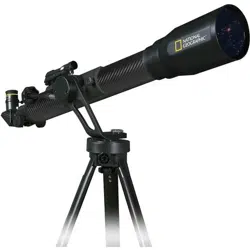Loading ...
Loading ...
Loading ...

4 Need Help? Toll Free 866.252.3811
Possible objects for observation:
We have compiled and explained a number of very interesting
celestial bodies and star clusters for you but we suggest that you
start practicing during the day focusing on terrestrial objects
such as Birds and or Trees at varying distances from you. On the
accompanying images at the end of the instruction manual, you can
see how objects will appear in good viewing conditions through your
telescope at varying powers (see pictorial examples below).
Terrestrial Views
Please note the example picture of Mount Rushmore. Start with
the 26mm Plössl eyepiece and focus until clear. After mastering
the focus with the 26mm change the 9.7mm eyepiece and practice
focusing and scanning until images become clear in the eyepiece.
We have included some additional examples that are possible with
your telescope such as a bird and a green on a golf course. DO NOT
POINT YOUR TELESCOPE DIRECTLY AT THE SUN OR BLINDNESS IS
POSSIBLE.
The Moon
The moon is the Earth’s only natural satellite.
Diameter: 3.476km
Distance: approx. 384,401km
The moon has been known to humans since prehistoric times. It
is the second brightest object in the sky (after the sun). Because
the moon circles the Earth once per month, the angle between
the Earth, the moon and the sun is constantly changing; one sees
this change in the phases of the moon. The time between two
consecutive new moon phases is about 29.5 days (709 hours).
Orion Nebula (M 42)
M 42 in the Orion constellation
Right ascension: 05:32.9 (Hours: Minutes)
Declination: -05:25 (Degrees: Minutes)
Distance: 1.500 light years
With a distance of about 1500 light years, the Orion Nebula (Messier
42, abbreviation: M 42) is the brightest diffuse nebula in the sky –
visible with the naked eye, and a rewarding object for telescopes
in all sizes, from the smallest field glass to the largest earthbound
observatories and the Hubble Space Telescope.
When talking about Orion, we‘re actually referring to the main part
of a much larger cloud of hydrogen gas and dust, which spreads out
with over 10 degrees over the half of the Orion constellation. The
expanse of this enormous cloud stretches several hundred light
years.
Ring Nebula in Lyra constellation (M 57)
M 57 in the Lyra constellation
Right ascension: 18:51.7 (Hours: Minutes)
Declination: -+32:58 (Degrees: Minutes)
Distance: 2,000 light years
The famous Ring Nebula M 57 in the constellation of Lyra is often
viewed as the prototype of a planetary nebula; it is one of the
magnificent features of the Northern Hemisphere's summer sky.
Recent studies have shown that it is probably comprised of a ring
(torus) of brightly shining material that surrounds the central star
(only visible with larger telescopes), and not of a gas structure in the
form of a sphere or an ellipsis. If you were to look at the Ring Nebula
from the side, it would look like the Dumbbell Nebula (M27). With
this object, we’re looking directly at the pole of the nebula.
Dumbbell Nebula in the Vulpecula (Fox) constellation (M 27)
M 27 in the Fox constellation
Right ascension: 19:59.6 (Hours: Minutes)
Declination: -+22:43 (Angle: Minutes)
Distance: 1,250 light years
The Dumbbell Nebula (M 27) in Fox was the first planetary nebula
ever discovered. On July 12, 1764, Charles Messier discovered this
new and fascinating class of objects. We see this object almost
directly from its equatorial plane. If you could see the Dumbbell
Nebula from one of the poles, it would probably reveal the shape of
a ring, and we would see something very similar to what we know
from the Ring Nebula (M 57). In reasonably good weather, we can
see this object well even with small magnifications.
Terrestrial Images
f=26mm
f=26mm
The Moon
Orion Nebula (M 42)
Ring Nebula in Lyra
constellation (M 57)
Dumbbell Nebula
in the Vulpecula
(Fox) constellation
(M 27)
f=9.7mm
f=9.7mm
Loading ...
Loading ...
